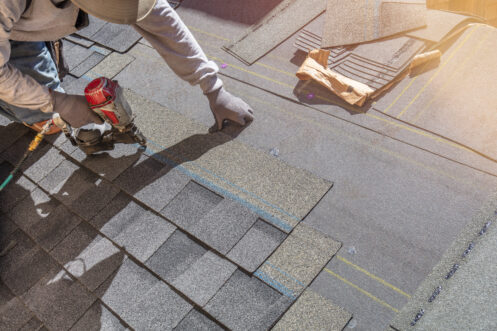As a homeowner, it is essential to keep your roof in good condition. This will help prevent structural damage and keep your roof from leaking into your house. Shingles are one of the first parts of a roof to see damage, and noticing when it happens will help you avoid water infiltration. When you do not address shingle issues, they are likely to get worse and cause a bigger problem. We will examine seven causes of shingle damage and discuss what steps you will need to take to fix them.
1. Severe Weather
Heavy rain makes shingles brittle over time, and with enough exposure to severe weather, the watertight seal where the shingles overlap can weaken. This allows leaks to form in the roof, and they will intensify with more severe storms. If leaks form, the potential for roof ripples and blisters is higher as well. These challenges arise because moisture gets trapped under the shingles, weakening the roof’s integrity over time.
Snow is heavy, and if you leave it on your roof to melt, it could deteriorate your shingles by making them brittle. Once shingles are brittle from the thawing and refreezing of snow, they become more prone to cracking. Another form of severe weather that often causes damage is hail. Depending on the size of the hail, these icy balls can do quite a bit of damage. One key indicator of hail damage is small round indentations on the roof’s surface.
2. High Winds
High winds accompany most severe weather, especially when you are experiencing a heavy thunderstorm or a hurricane. Wind is one of the most destructive issues that you will face with a shingled roof because it can rip the shingles right off the surface. In addition, strong wind can bend and knock shingles loose. This is often seen along the edges of the roof.
Damaging winds also carry debris that can damage your roof. The debris that you see in the wind can be small or large. For example, a tree branch could break off and move with the wind. Branches that break during a storm can crash onto your home and damage the roof. With forceful impact, a hole in the roof could result. Before big storms, make sure to check for any branches near your home that pose a threat.
Hurricane-force winds start at 74 mph and have been known to exceed 200 mph, so if your home is affected by a hurricane warning, take steps to protect your roof, or damage will occur. High winds can also cause damage to gutters and flashing.
3. Exposure to Sunlight
The heat and the ultraviolet (UV) rays from the sun can damage a shingled roof. When the roof is under the strain of the sun day in and day out, the asphalt dries out, making the shingles brittle. Brittle shingles crack and break over time, and when you see the shingles beginning to change colors, the damage has already begun.
When oxygen mixes with cracked or broken asphalt, the protective coating on the roof decomposes and breaks down even more. As damage to the coating happens, granules from the shingles loosen and fall into the gutters and along the edge of the roof.
To prevent this type of damage from occurring, you can consider shingles with a higher solar reflectance index (SRI). The higher the SRI, the cooler your shingles can stay in sunlight so that they do not transfer extra heat to your home. This can help save energy since you will need less cooling during the summer.
4. Temperature Fluctuation
Temperature fluctuation is a common thing in Charlotte, NC, and when high temperatures suddenly drop, shingle roofs can crack and warp. This may not seem like a big issue, but enough cracks will lead to leaks, especially if other shingle damage is present.
In the summer heat, the shingles will contract and potentially deteriorate at a faster rate. Then, in the winter, the same shingles will expand and freeze. This allows water to get between the shingles, potentially damaging your roof. Even if the temperature difference is not massive throughout the year, the material’s continual expansion and contraction will loosen brackets and flashing.
5. Moss Growth
Organic matter like moss and algae grow in the moist conditions present between the shingles on your roof. With continual growth, it can cause damage to the structural integrity of the roofing materials. Because of the continual freezing and thawing of a roof in winter, moss can thrive quickly and multiply. As the moss grows, it lifts shingles from the roof, which can cause leaks. If enough moisture invades the cracks of the roof, then mold can form as well. Once this occurs, it requires professional removal.
6. Improper Installation
Whenever untrained professionals install shingles on your roof, there is a chance that their placement may not be correct. If the shingles are not attached to the roof so that the adhesive keeps them in place, a strong gust of wind can lift them. If you plan on laying shingles, contact a member of our team at Blue Fox Roofing & Renovations, and ask about roof replacement services. We have the equipment to ensure that we do the job right, giving the shingles on your roof a longer lifespan.
During installation, misaligned or overlapping shingles may not adhere as well to the roof. Also, inadequate ventilation on the roof can cause heat buildup, which can cause the shingles to detach prematurely.
7. Age of the Shingles
If you are seeing evidence that your shingles have damage, then take the age of the roof into consideration. The lifespan of a roof with shingles averages 15 to 30 years. The older shingles get, the more likely their protective coating is wearing away, which means that sun damage and leak possibilities will increase.
If you are getting a new shingle roof installation, consider the type of damage that you see the most. If it is traditional wear and tear, the same type of shingles will be fine for an upgrade since this damage will occur over time. If the damage is from wind or impacts from hail, an impact-resistant option may be a better choice for your needs. These shingles tend to be more durable.
Contact Our Roofing Company Today
After a major storm, it is important to get a professional roofing assessment of the damage so that you can have repairs made quickly. At Blue Fox Roofing & Renovations, our team will do a visual inspection to see if there is any damage or if any shingles are missing. We will check the structure of the roof for sagging as well as to ensure that there are no leaks. Once the inspection is complete, our team will decide whether a repair job or a full roof replacement is best for your home. We take care of repairs and replacements from storm damage as well as other roofing issues in Charlotte.
Contact us at Blue Fox Roofing & Renovations today to schedule an inspection and any necessary repairs to keep your roof safe throughout the upcoming storm season.




